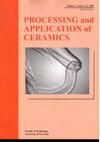Microstructure and electrical properties of microwave sintered Nb-doped NBT ceramics
IF 0.8
4区 材料科学
Q3 MATERIALS SCIENCE, CERAMICS
引用次数: 0
Abstract
Nb5+-doped sodium bismuth titanate (NBT) ceramics ((Na0.5Bi0.5)1-x/2Ti1-xNbxO3 where x = 0, 0.005, 0.01 and 0.015) were obtained by microwave assisted solid state reaction route and microwave sintered at 1000 ?C. Microwave processing technique was chosen for the sintering as it is a powerfulmethod which enables sintering in a short time with fast heating rate avoiding grain growth. The influence of Nb5+-doping on microstructure and electrical properties of the NBT ceramics was studied. X-ray diffraction analyses revealed that solubility limit of niobium in NBT lattice is up to 1mol%, as with further increase in niobium concentration pyrochlore appeared. Microstructure of all the ceramics was investigated by field emission scanning electron microscopy and it was observed that the average grain size decreased with doping. Temperature dependent dielectric study was carried out for all the ceramics at different frequency. All ceramics show diffusive dielectric behaviour around Tm and introduction of Nb even increases compositional fluctuation compared to the parent NBT. Nb-doping shifts the Tm toward lower temperature. Leakage current study showed that for whole range of electric field ohmic type conduction mechanism is dominant for all the ceramics. Room temperature polarization-electric field (P-E) hysteresis loop confirms the ferroelectric behaviour of all the ceramics.微波烧结掺铌NBT陶瓷的微观结构和电学性能
采用微波辅助固相法,在1000℃下微波烧结制备了掺Nb5+的钛酸铋钠(NBT)陶瓷((Na0.5Bi0.5)1-x/2Ti1-xNbxO3,其中x = 0、0.005、0.01和0.015)。选择微波处理技术进行烧结,因为它是一种强大的方法,可以在短时间内烧结,加热速度快,避免晶粒长大。研究了Nb5+掺杂对NBT陶瓷微观结构和电性能的影响。x射线衍射分析表明,铌在NBT晶格中的溶解度极限为1mol%,随着铌浓度的进一步增加,出现焦绿石。利用场发射扫描电镜对陶瓷的微观结构进行了研究,发现随着掺杂的增加,陶瓷的平均晶粒尺寸减小。对所有陶瓷在不同频率下的介电特性进行了温度依赖性研究。所有陶瓷在Tm周围都表现出扩散介电行为,与母材NBT相比,Nb的引入甚至增加了成分的波动。nb掺杂使Tm向更低的温度移动。泄漏电流研究表明,在整个电场范围内,所有陶瓷的欧姆型传导机制都占主导地位。室温极化电场(P-E)磁滞回线证实了所有陶瓷的铁电行为。
本文章由计算机程序翻译,如有差异,请以英文原文为准。
求助全文
约1分钟内获得全文
求助全文
来源期刊

Processing and Application of Ceramics
MATERIALS SCIENCE, CERAMICS-
CiteScore
1.90
自引率
9.10%
发文量
14
审稿时长
10 weeks
期刊介绍:
Information not localized
 求助内容:
求助内容: 应助结果提醒方式:
应助结果提醒方式:


